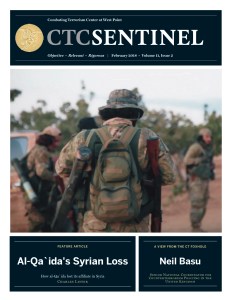
Abstract: With the fall of Raqqa, many foreign fighters from the Islamic State have since fled territory previously controlled by the group—some returning to their countries of origin within Europe. United States law enforcement entities, with assistance from the U.S. Department of Defense, are leveraging partnerships within Europol to identify returning foreign terrorist fighters and prevent attacks on both U.S. and European soil. This article focuses specifically on Homeland Security Investigations’ (HSI) role in this effort. International and interagency counterterrorism cooperation benefits from Europol’s unique multilateral coordination tools to deter and defeat both terrorist and criminal threats.
As Islamic State fighters flee Iraq and Syria for their countries of origin,1 law enforcement, not the military, is the entity best positioned to curtail the terrorist threats they pose.a For the United States, much of the international counterterrorism fight carried out within conflict zones, such as Iraq, Syria, Yemen, and Libya, is primarily military in nature. External to these areas, the U.S. military, whose authorities are especially limited in Europe, has sought to enable law enforcement to provide the “finish” option: arrests and prosecutions. This mission, Operation Gallant Phoenix (OGP), was originally focused on tracking foreign fighter flows into Syria and Iraq, but its charter has been expanded to address these individuals returning to areas throughout Europe. The United States’ European Command (EUCOM), seeking to leverage its partnerships with law enforcement, funds several U.S. Homeland Security Investigations (HSI)b special agents who work at Europol but also assist EUCOM in identifying transnational European-based criminal and terror threats. This effort supplements an already large U.S. interagency presence at Europol, which provides both opportunities and challenges as a medium for coordination. Despite the growing pains associated with the recent expansion, law enforcement enablement against foreign terrorist fighters is resulting in increasing numbers of investigations and arrests throughout Europe due to the rapid flow of information and tremendous resources available within Europol, the newest member of OGP.2
This article draws on insights the author gained during the approximately three months he spent as an HSI embed at Europol headquarters during the summer of 2017. This article focuses on the contributions of HSI to Europol’s work. It is not intended to capture the totality of partnership activity between U.S. law enforcement agencies and Europol and should not be read as a comprehensive assessment of all cooperation between these entities. Unless otherwise specified, the information contained in this article is based on interactions with U.S. and European officials working there during this period.
European CT Cooperation Mechanisms
Located in The Hague, Europol maintains a staff consisting of over 1,000 people representing all 28 E.U. member nations and an assortment of 33 operational and strategic partners.3 The United States is an operational partner, enabling cooperation similar to a member nation but without direct access to the Europol criminal database. The database, called the Europol Information System (EIS), is one of the most unique capabilities of Europol, hosting records from almost 300,000 cases across member nations and operational partners. The EIS enables cross matching and multilateral cooperation across the millions of investigatory subjects entered in the database, which represents a multinational capability not found elsewhere in the law enforcement realm.c Europol also utilizes a secure messaging system that enables rapid multilateral information sharing across all of its partners. As the Deputy Director of Europol Wil van Gemert previously told this publication, Europol “moved from not only collecting information but to connecting information.”4 Using assets like EIS and experienced counterterrorism professionals from multiple countries, the new European Counter Terrorism Centre (ECTC) contains a growing U.S. presence that helps combat the foreign terrorist fighter threat.
The ECTC, established in 2016, has only recently featured a semi-permanent U.S. presence. In the aftermath of the Paris terror attacks in November 2015, subsequent U.S.-enabled investigations illuminated an Islamic State-affiliated network that funded the perpetrators’ travel and daily expenses.5 This support network utilized a system of Money Service Businesses (MSBs) and criminal networks to fund illicit activity, allegedly to include the purchase of false official documents and weapons once the Paris attack perpetrators reached continental Europe from Syria.6 Europol and U.S. officials have pointed out that the increased interweaving of criminal and terrorist networks can provide an advantage for investigators.7
Much of the specifics of the Paris investigation remain publicly unavailable as there are still ongoing trials for the support network in Belgium, France, and other countries. However, HSI and the Federal Bureau of Investigation (FBI) were integral members of the ECTC that helped identify these financial links.d Though not well known among the general public, HSI—as the investigative arm of Immigration and Customs Enforcement (ICE)—has broad statutory and legal authority to investigate illicit trade, travel, and financial activities as well as a number of other threats. Due to its unique border authorities, HSI is positioned to acquire, analyze, and share U.S.-based MSB data.e HSI agents provided a quick turn-around on the Paris attack investigations, resulting in an increased demand from Europol member nations for investigative assistance.
HSI is the largest investigative body within the Department of Homeland Security (DHS), with over 6,700 special agents. Currently, HSI agents and analysts are working alongside Europol partners in the ECTC, with additional HSI agents working in the European Migrant Smuggling Centre (EMSC). The HSI agents within the EMSC fulfill a critical function as they collect information and provide analysis on criminal smuggling and Special Interest Alienf illicit travel, which helps further protect U.S. borders. The nature of unclassified financial information provides HSI a distinct advantage: they can openly share financial information with European partners, which expands a quid pro quo relationship with Europol members.
HSI and the U.S. government in general benefit from increased awareness regarding terrorists and illicit travel facilitators operating in Europe that could also threaten U.S. national security, public safety, and border security. From January 2016 through July 2017, HSI agents identified 1,843 known or suspected terrorists and 9,774 illicit Special Interest Alien travel facilitators by answering 984 requests for information from European partners.8 With HSI’s cooperation with Customs and Border Protection (CBP) and other law enforcement partners, these investigatory subjects can be added to watchlists and prevented from entering the United States, further protecting the homeland. The role of law enforcement agents at Europol is not without challenges, however.
The Challenges of Cooperation
An exponential growth in both Europol’s role and the number of requests for assistance from European partners constantly strain the capacity of the HSI agents at Europol. Although HSI shares information acquired from U.S.-based MSBs with European partners, the financial transaction data requires additional analysis by all-source intelligence analysts to identify potential links to any U.S.-based entities. The rapid growth of requests from European partners for this financial information has also caused procedural challenges, resulting in a duplication of analysis effort as both CBP and the FBI, along with seven other U.S. agencies, receive the same requests within the counterterrorism space. Recent changes have streamlined the process, with OGP requests being handled specifically through the FBI. The addition of a Europol representative at OGP in August of 2017 is also a new factor in communication, and could potentially streamline the process for sharing information originating from the small amount of contested space still controlled or influenced by the Islamic State.
HSI, FBI, and CBP assign the ECTC and EMSC portfolio to their permanent agents as an additional duty, but it might not replicate the benefits of an agent working full-time inside the ECTC or EMSC. Although EUCOM guaranteed funding through FY18 for additional HSI agents, there are inherent challenges with the current 90-day rotations such as case continuity, rapport with partners, and domain knowledge.
Another undermentioned aspect of potential conflict for Europol and interagency cooperation rests in a differing view of the role bilateral cooperation plays in defeating terrorist threats. Certain U.S. agencies have a propensity for protecting what they consider proprietary information. At times, information may be over-classified. Agencies are then constricted to a formal sharing process based on classification, but some also prefer to share information bilaterally due to historic relationships.9 Some E.U. member states also prefer to work counterterrorism investigations bilaterally with U.S. law enforcement, potentially degrading opportunities to share information more broadly through Europol. This latter process is cumbersome, and with the geographic proximity of so many countries on the European continent, bilateral sharing alone could prevent a member state from quickly receiving pertinent information about credible threats. Europol as an entity has become more operational in the aftermath of the migrant crisis and the renewed terrorist threat of the last few years. Europol’s secure messaging system, SIENA, combined with the robustness of its criminal database, EIS, provides an invaluable resource in both rapid information sharing and cross matching, as highlighted through the effective cooperation that led to rapid arrests in three countries in the aftermath of the Paris attacks.10 This burgeoning capacity is a source of disquiet for those who believe that the best way to share information still rests more in traditional bilateral exchanges.
Despite those challenges, the HSI attachments to Europol have been successful in a variety of ways. Although details on most of the ongoing investigations remain limited due to ongoing legal proceedings, a recent prominent case provides a positive example of the burgeoning cooperation between elements of the U.S. government and Europol. This named operation started after an eminent Islamic State financier was detained by the U.S. military within a conflict zone. Based on evidence recovered from sensitive site exploitation, HSI began analysis of his financial links and conveyed a number of critical leads to European nations through the use of both SIENA and Europol relationships. Cooperation between HSI, the U.S. Department of Defense, and Europol on this specific case thus far has contributed to over 130 open investigations and 15 arrests in France, Belgium, Germany, and other European countries.11 Another significant operation includes Operation ERMIS, where HSI in The Hague provided over 2,000 financial leads on document forgers, which led to 19 separate arrests in Greece and the Czech Republic in 2016.12 Further investigation into these illicit travel rings indicated ties to both transnational criminal organizations and possible foreign terrorist fighter movements. This type of coordination benefits from the unique authorities HSI agents possess, their relationship with European and U.S. partners, and their understanding of transnational threat networks.
Improving the Process
A few critical changes could streamline the processes at Europol. There is an intrinsic benefit in the current configuration with agents collocated inside the EMSC and ECTC: they develop relationships, share information, and engage in the daily operations that improve any multilateral collaborative effort. However, with FBI, CBP, HSI, and seven other U.S. agencies working within the same Europol organization, the U.S. agencies lack a cohesive leadership structure, which creates some confusion among European partners. The disparate U.S. elements inside the ECTC all work under different legal authorities as well. For example, the FBI has statutory lead for U.S. counterterrorism investigations. However, there is only a known or suspected U.S. nexus or involvement in approximately five percent of counterterrorism labeled requests to U.S. agencies for information by European partners via their secure messaging system, SIENA.g The other 95 percent of requests by European partners may not meet the threshold for FBI involvement, which is why HSI has an advantageous role in providing financial information and in turn receiving information that identifies these subjects of investigations and potentially prevents them from entering the United States.
The growing capability of Europol might justify the addition of more permanent U.S. law enforcement liaison positions within Europol. Additional analytical support could also help with faster processing of requests, enabling agents to be more proactive as with the case of the aforementioned Islamic State financier. That analytical support could be collocated at Europol or staged within the U.S. National Targeting Center or another D.C.-based center with a focus on allowing reach-back analysis for the forward-deployed agents. U.S. agents assigned to Europol across all law enforcement agencies would benefit from more continuity and a better system of internal information sharing that fully captures the intricacies of the work being done at Europol.
Despite the potential challenges that exist at Europol and with the various agencies assigned, the overall benefit of the program is significant. Through collaborative efforts with European partners, U.S. law enforcement is addressing the challenges of combating terrorism in an area where their legal authorities are limited. As foreign terrorist fighters return to their countries of origin or travel through the porous borders of Europe, the increased efforts of the law enforcement entities throughout Europol will help to pursue and hopefully defeat the terrorist threat outside of the conflict zones. CTC
Miles Hidalgo is an MPhil candidate in International Relations at Oxford University as a Downing Scholar. He is an active duty U.S. Army officer with experience in special operations.
The views and opinions expressed in this article are those of the author and do not necessarily reflect the official policy or position of any agency of the U.S. government.
Substantive Notes
[a] Nick Rasmussen, former NCTC Director, qualified this concern in a recent interview in this publication. Rasmussen stated that the outflow of foreign fighters from the former Islamic State-controlled territories was not reaching the volume that intelligence agencies anticipated two years previously. He stressed the focus was now on the “quality rather than quantity” of returning foreign fighters. See Paul Cruickshank, “A View from the CT Foxhole: Nicholas Rasmussen, Former Director, National Counterterrorism Center,” CTC Sentinel 11:1 (2018).
[b] HSI is the investigative arm of the U.S. Department of Homeland Security’s Immigration and Customs Enforcement (ICE). The organization’s stated mission is to protect the United States and uphold public safety, which it fulfills by identifying criminal activities and eliminating vulnerabilities that pose a threat to the nation’s borders.
[c] The INTERPOL database is rarely used by E.U. and U.S. law enforcement due to its unrestricted access by states that may sponsor and benefit from illicit activity, such as Russia. Both Europol and U.S. officials highlighted this advantage in interviews with the author in the summer of 2017.
[d] U.S. Customs and Border Protection (CBP) and Diplomatic Security Services (DSS) are also members of ECTC that assist in ongoing investigations.
[e] HSI is authorized under Title 19, section 1401 of the U.S. Code to cross-designate other federal, state, and local law enforcement officers to investigate and enforce customs laws. Due to the broad reach of customs laws, Title 19 authorities enable HSI to investigate any lead that may be relevant to the illegal movement of people or goods across the border.
[f] As defined by DHS, a Special Interest Alien is a person seeking entry into the United States who originates from “specially designated countries that have shown a tendency to promote, produce, or protect terrorist organizations or their members.” “Supervision of Aliens Commensurate With Risk,” Department of Homeland Security, Office of Inspector General, December 23, 2011, p. 8.
[g] This estimate is based on the author’s interview with senior ICE officials and analysis of SIENA statistics from FY 2016 and 2017. SIENA has the option to “bin” or “tag” the requests for information in order to direct it toward a specific U.S. agency. In this case, the percentages refer to the number of requests for information, sent through SIENA, that arrived in the counterterrorism inbox for U.S. agencies at Europol.
Citations
[1] Paul McLeary, “SitRep: ISIS 2.0 On the Way,” Foreign Policy: The Cable, October 18, 2017.
[3] “Staff Statistics,” Europol.
[5] Author interview, HSI supervisory special agent, June 2017.
[6] Ibid.
[7] Cruickshank.
[8] SIENA statistics from FY16 and FY17 were obtained by the author.
[9] Author interview, senior FBI special agent, June 2017.
[10] Author interview, ICE supervisory special agent, June 2017; Cruickshank.
[11] Numbers are based on SIENA statistics from E.U. member nation reports.
 Skip to content
Skip to content


